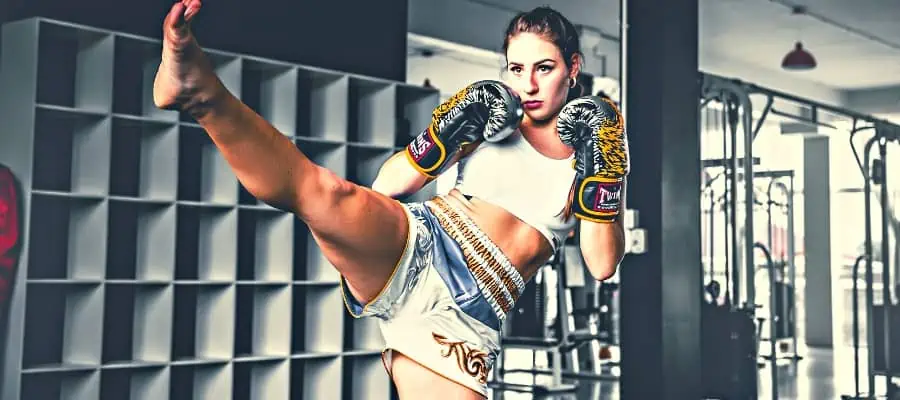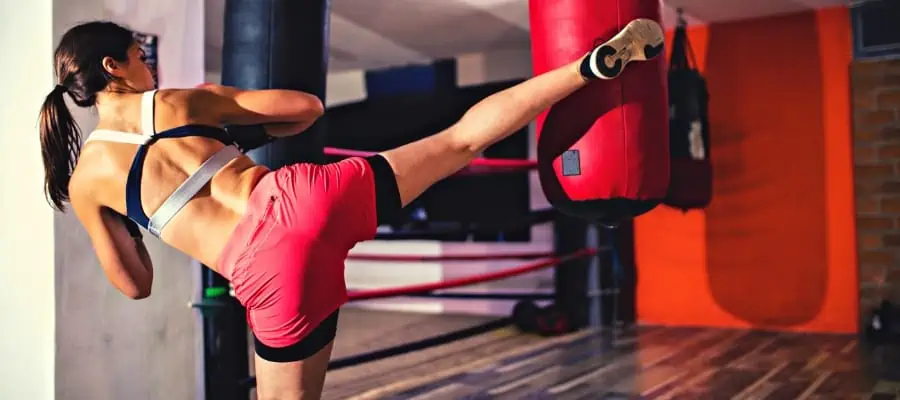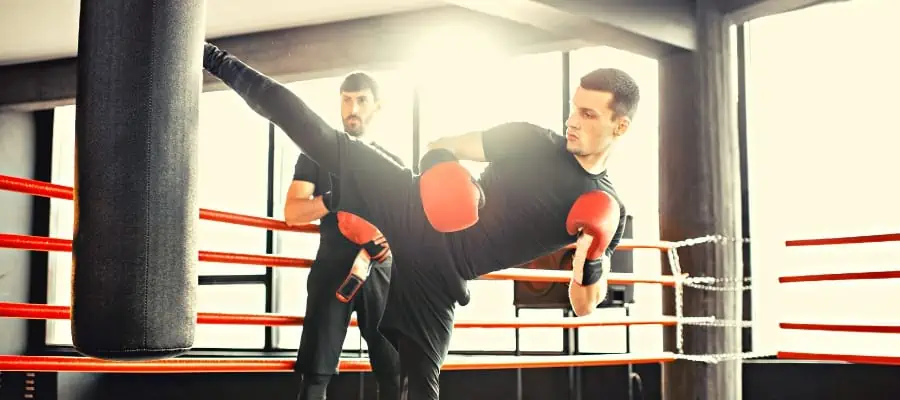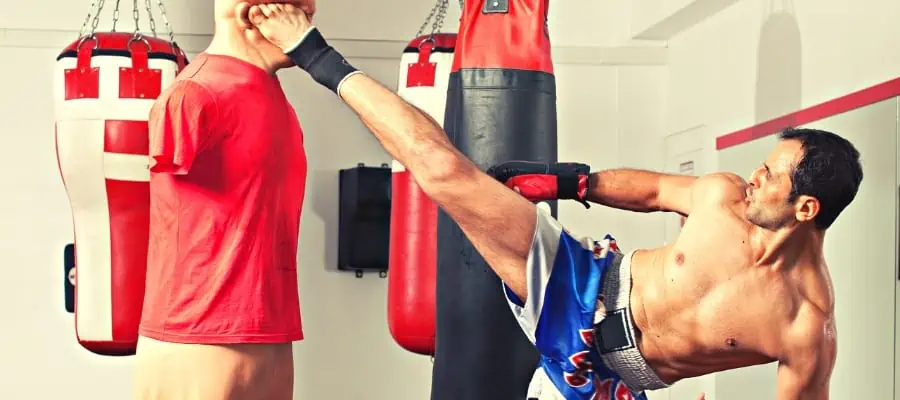Having good kicks is an important addition to any martial artist’s arsenal. When elevated to a higher level, they are a weapon that can be used to instill fear in the opponent. They help in knocking the opponent out of balance, causing damage, but also in defense. Quality kicks can end the fight quickly, but having a hard kick is much more than hitting with all your force.
There are too many factors that can affect the results. It is necessary to know that one thing depends on another. Solid physical form is needed for a martial arts athlete to achieve quality kicks because they use multiple body muscles for proper performance.
That is why it is necessary to work on improving those muscles. With good physical form and correct performance technique, it requires time and effort to bring all other factors to the desired level. It is safe to say that a hard kick can be defined as a set of several qualities brought to a certain degree, trained, and executed appropriately.
You Are Performing Kicks With the Correct Technique

The most important thing when performing any punches or kicks in martial arts is to have a clean and flawless technique. Proper execution involves multiple small details executed correctly.
When throwing a leg kick, your leg should not have any weight, and it should be thrown like a whip. Led by the torso, shoulders, and, most importantly, the hips. For the fluidity and power of the shot, your standing foot should be on your toes.
That will allow for better hip rotation and better impact power. This also allows for better stability and a quicker return to your initial stance. It’s not enough to lift your standing leg onto your toes; you must rotate it to allow your kicks to generate more penetrating power.
Always aim for your shin to go through the opponent and not slow down when hitting them. The hand on the same side as the leg you are throwing should give an extra push to your kick, so for these reasons, it should be pulled towards the opposite side concerning the path of your leg.
Of course, it depends on what kind of kick it is, but most kicks work with the same technique. The most important thing to know is that the power comes from the hips, whether you are tilting your hips to the side for a roundhouse kick or tilting them back for a spinning back kick.
Taekownodoists, for example, have faster, more stable, and more controlled kicking techniques than kickboxers and Thai fighters. Still, Thai fighters and kickboxers have more destructive power. This is all due to throwing the leg from the knee instead of the hip and less work with their arms. It’s their technique, though, and it’s correct, but if you want stronger kicks, bring your hips in.
You Invested a Lot of Repetition

To achieve a good technique, it is necessary to invest a large number of repetitions of each kick. This means it will take an incredible amount of time to actually do it perfectly. It can often be tiring for both the body and the brain, but with each repeated kick, a small percentage improves. It requires patience and hard work. So the math is simple, the more you invest, the more you will get.
Your body and brain need to get used to the kicking motion. At each attempt, your focus should be on the kick. After more training and working on the technique, you will start to feel that you need less and less concentration to get the shot right because the brain has memorized the movement of the muscles.
After learning the technique properly, you must repeat that technically correct kick to increase its power. Don’t practice until you can do it right, but practice until you can’t do it wrong. This is why professionals repeat basic techniques every day for years because drillers make the killers. It is logical to expect power in your kick if you have a lot of repetitions on the heavy bag or pads.
Your Kicking Power is in Your Speed

One of the three essential links for hard kicks is speed. It includes the speed with which the shin or foot travels to the desired target and the pace with which the leg returns to its original position or fast retraction.
When throwing kicks, taking the path of least resistance is correct. It means throwing your leg to the target as quickly and safely as possible. Suppose your kick has a wide range of motion or a longer trajectory. In that case, it is logical that reaching the opponent will take longer, and you will have a high chance of hitting him in the guard or elbow.
Because of this, it is necessary to raise the “deadweight” leg straight toward the opponent, and at the last moment, you should insert a hip movement. It will enable a shorter and faster trajectory of the kick and, therefore, safer due to bypassing the opponent’s guard and hitting the target cleanly.
The second thing is a quick retraction, which means quickly returning the leg to the starting position. The goal is to retrieve the kick after hitting the opponent, and the swift retraction will give you an extra push in terms of impact power due to the quick return of the kick. In addition to speed and power, it also has the benefit of returning you to a stable stance as soon as possible to compose further attacks.
You Know the Timing of Your Kick

Another essential link in hard kicks is your timing. It is the ability to time and execute the kick in a method that is difficult to block or avoid. Clean hits in martial arts are the ones that are thrown at the right time. And hits that the opponent does not see are, in most cases, the ones that knock him out or at least knock him down. That is why it is necessary to devote your time to developing the timing of when you need to kick.
Timing is closely related to speed and is deadly in combination with it, but it’s still different. Timing alone does not mean having a hard kick, but timing is one of the components of having a heavy and lethal kick. So, it is mathematically safe to say that accurate timing plus high speed give a powerful hit, in this case, a hard kick.
You Put Your Power Into Accuracy

The third link of the hard kick is its accuracy. Accuracy means your ability to hit your opponent’s weak spot. Same as with speed and timing, it has to be trained over time to execute a lethal kick, and its prerequisite, as with the previous two links, is the correct technique.
Suppose you’ve ever hit an opponent in the liver or jaw with a precise kick or a punch. In that case, you understand its importance and benefits. Even throwing the precise hit with a low kick to the nerve on the leg will not leave the opponent indifferent.
It is necessary to understand the connection of the links, which means that in the complete package of practiced timing, technique, speed, and precision of the kick, you get greater impact power and, therefore, the final effectiveness of your hit.
You Have Strong Legs

Building strength for the lower extremities is crucial for hard kicks. If the rule is that the stronger your legs are, the harder you will throw punches, then strengthening your legs is supremely valid for building up your kicks. The legs are a large muscle group, and the dominant muscles responsible for strong kicks are the hamstrings, quadriceps, gluteus, and abductor muscles on the inner and outer thighs.
The generation of force starts from the ground, and the fighter should know how to redirect that force from the legs through the hips and into the opponent. Building powerful and functional muscles should be obligatory but not too massive for thighs.
Various exercises can be used for this purpose, including sumo deadlifts, squats, and lunges. Exceptional attention should be paid to exercises that isolate the work of one leg, such as one-legged squats. Weight training shouldn’t last long, so using 80% RM for three to five sets should be plenty.
It means if you spend an extra half hour in the gym using weights, you can expect a solid improvement in the power of your kicks. Strengthening your legs also increases the strength of your joints and bones and, thus, your kicking power. After all, leg strengthening has many other benefits for fighter performance and safety besides powerful leg kicks.
You Have Strong Core Rotation

Training for every martial art is unthinkable without utilizing abdominal muscles and conditioning exercises. The abdominal wall plays an outstanding role when it comes to the strength of your kicks and punches. It is important to note that it also plays a role in the grappling segments.
As written, force generation from the ground goes through the legs. It is executed by rotating the hips for any type of effective kick. Your abdominal muscles assist you in this rotational power because kicks engage a large part of the abdominal muscles and generate the additional force needed for a powerful impact. A martial arts athlete’s abs should be functional, durable, and rock solid.
There is a wide range of exercises with and without equipment. They can help build and strengthen the abdominal wall. Considering that the abdominal muscles rest quickly and do not require a lot of energy, it is possible to dedicate yourself to them a little bit every day. So, strong abs give a strong rotation, and a strong rotation produces a hard kick.
In addition to rotational power, your abs are your armor, and their shape has benefits such as better posture, stability, easier breathing, and overall strength. They also facilitate faster and better movement in stand-up and on the ground.
You Have Strengthened Your Lower Back

Lower back strength is another of the primary muscles needed to generate kick power, in conjunction with the leg and abdominal muscles. An effective kick should come from a stable platform where the lower back muscles work. The lower back is responsible for the stability of your spine and pelvis, which is crucial for the quality production of force in your kick, and they also help in the rotation of the torso.
The back absorbs the force produced by the impact of the kick. It helps with bending the back when throwing a kick which can have a positive effect when it comes to kicking range and giving extra momentum. Arching the back is also associated with lower back pains, so it is necessary to develop the correct technique and know the limitation of flexibility to which one should go.
A couple of repetitions to strengthen them will be a quality addition to your already existing martial arts training plan, and they also help to eliminate lower back pain, which is a widespread problem.
You Are Flexible

The strength of your legs is just as important as their flexibility when it comes to hard leg kicks because strength and flexibility work together. Flexibility increases the range of motion of your legs, helps you control it, and increases the accuracy of the kick. With quality flexibility comes more fluid movement of the whole body. It is slow work and requires patience and continuity for its progress, which is unquestionably worth it.
It is substantial to emphasize that before stretching, you should raise your body temperature with a quality warm-up to avoid any kind of injuries if you do a stretching session without strenuous training. If you have done a hard workout, finishing it with a cooldown of a couple of flexibility exercises is mandatory.
Stretching is certainly beneficial for many other aspects of martial arts and overall health. It should not be avoided under any circumstances, especially not if you want to have hard kicks.
You Do Plyometrics For Explosive Movements

Explosive movements are another essential factor for having hard kicks, so it is important to include explosive plyometric exercises in a plan for better kicks. Plyometrics is crucial to a fighter’s speed and strength evolving into greater power. It is designed to develop fast and explosive movements in the shortest possible time.
Plyometrics is generally crucial for good performance in all martial arts. This type of training is performed in short series and repetitions but with maximum effort when performing the given exercise. The exercises used to build explosive legs mainly involve jumps, such as box jumps, skipping ropes, deep jumps, long jumps, and the like.
If you are more experienced and advanced in this type of training, you can also add weight training, a resistance band, and work with a medicine ball. Plyometric footwork also benefits getting in and out quickly during a fight.
If you found this article useful, you may want to save this pin below to your Combat Sports board.

Recent Posts
What is Manachai's Fighting Style? Unveiling Muay Thai Mastery
Manachai, a celebrated figure in the Muay Thai world, has captivated audiences with his exemplary martial prowess. Hailing from the heartlands of Thailand, his name is synonymous with the art of...
What Was Chamuekpet Hapalang's Fighting Style? Unveiling Techniques
Chamuekpet Hapalang was a renowned figure in the world of Muay Thai (record 200-48-2), embodying a fusion of Muay Bouk and Muay Khao styles. Originating from Thailand, the art of Muay Thai is known...
